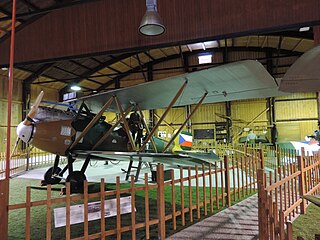Related Research Articles

The Letov Š-1 was a Czechoslovak single-engined, two-seat biplane surveillance aircraft. It was the first military aircraft built in Czechoslovakia. It was designed by Alois Šmolík at Letov Kbely. The Š-1 first flew in 1920.
The Kawasaki KDC-2 was a 1920s Japanese light civil transport which Kawasaki developed from its Kawasaki Army Type 88 Reconnaissance Aircraft. Two were built and flown in 1928 and flew both regular and irregular services; the last retired in 1935.

The Sablatnig P.III was an airliner produced in Germany in the early 1920s.
The Kawanishi K-7 Transport Seaplane was a Japanese single-engined biplane floatplane of the 1920s. Eleven were built from 1924 to 1927, being used to carry passengers and airmail.

The Zeppelin-Staaken Riesenflugzeuge were a series of very large bomber aircraft - Riesenflugzeuge, usually powered by four or more engines, designed and built in Germany from 1915 to 1919.

The Kawanishi K-8 Transport Seaplane was a Japanese single-engined floatplane of the 1920s. Seven were built in 1926 and 1927, and were used to operate airmail services.

The LFG Roland G.I was a large prototype single-engine biplane bomber built in Germany in 1915, during World War I. It had a single engine buried in the fuselage driving pusher configuration propellers mounted on outriggers.

The LVG G.III was a large, twin engine triplane bomber built in Germany near the end of World War I. Only one was completed.

The Siemens-Schuckert L.I was a large, three-engined biplane bomber aircraft, built in Germany towards the end of World War I. It was a twin boom design, strongly influenced by the successful Caproni Ca.3. Three were built but not used operationally.

The Blériot XXI was an early French aircraft built by Blériot Aéronautique.

The Albatros L 83 Adler was a small, fast transport aircraft for passengers, mail or other cargo, flown in Germany in 1931. Two were built.
The Polikarpov PM-1 was a passenger aircraft created by Polikarpov in the 1920s.

The Zeppelin-Lindau Gs.I, often known post-WWI as the Dornier Gs.I after its designer Claude Dornier, was a civil flying boat developed immediate post-war from a military prototype. Its passenger cabin seated six. Only one was completed, and that was eventually scuttled to keep it out of Allied hands. Another of the military prototypes was intended to have a bigger, nine seat cabin and other refinements but the Gs.II was incomplete when discovered by Allied inspectors.
Kawanishi's first aircraft, the Kawanishi K-1, was designed as a mail carrier. It was the first Japanese aircraft to receive a Certificate of Airworthiness from the Aviation Bureau. It won a prize in a national contest but was not a commercial success and only one was built.

The Kawanishi K-6 was a passenger-carrying biplane floatplane, built in Japan in the 1920s. The sole example took part in an around Japan flight then flew as a transport with Japan Aviation.
The sole Kawanishi K-2 was the first specialized Japanese racing aircraft. The advanced, Junkers-influenced, single seat monoplane's first flight was in the late summer of 1921. It had a promisingly high maximum speed but a career limited by numerous minor accidents produced no victories or records.
The Kawanishi K-3 was a Japanese, fast, multi-purpose civil transport aircraft from the early 1920s. Despite its good performance it was eclipsed by the release of Army surplus machines and only one was built.
The Itoh Emi 16 Fuji-go (Fuji), built in 1920, was intended as a cheap and simple general purpose civil biplane but gained publicity with exhibition flights and successful speed and altitude contests against higher-powered fighter aircraft.
The Itoh Emi 29 Taihoku-go was a 1920s Japanese civil transport with its two passengers in a enclosed cabin. It was the first of this "limousine" type to be built in Japan; the only example flew the Osaka-Tokyo route for a while.
The Fukunaga Tenryu 10 was the largest Japanese civil passenger aircraft when it first flew in 1922. Its passenger cabin seated four.